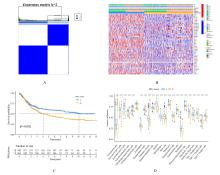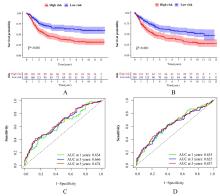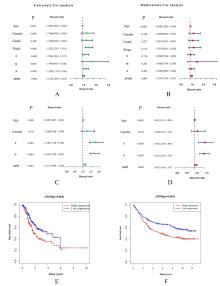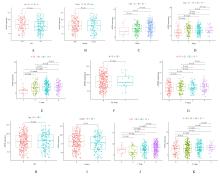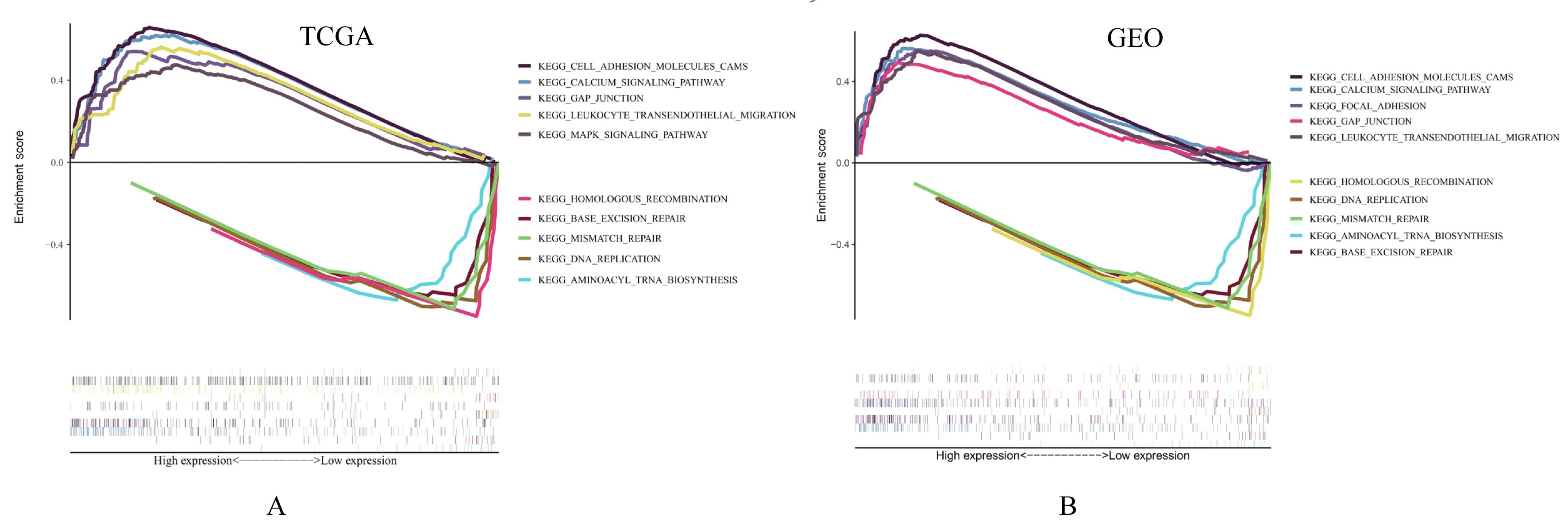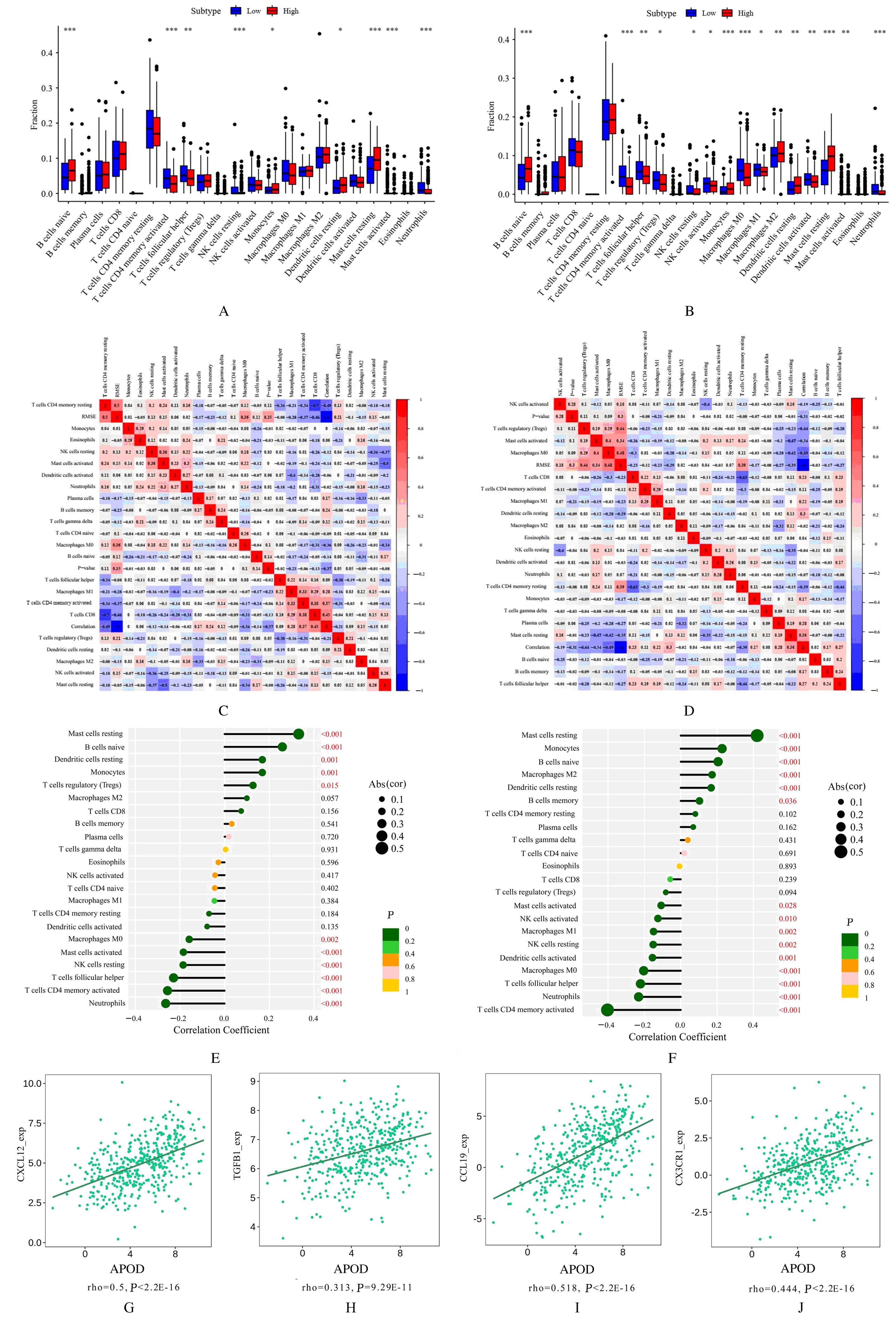Journal of Jilin University(Medicine Edition) ›› 2023, Vol. 49 ›› Issue (5): 1268-1279.doi: 10.13481/j.1671-587X.20230521
• Research in clinical medicine • Previous Articles
Bioinformatics analysis on predition effect of subtypes of cell pyroptosis and APOD on prognosis of gastric cancer patients
Haikang CUI1,Xudong ZHANG1,Xiaoning LI1,Xi YANG1,Lan YANG1,2,Wenjie ZHANG1,2( )
)
- 1.Department of Pathology, School of Medicial Sciences, Shihezi University, Shihezi 832002, China
2.Key Laboratory of Xinjiang Endemic and Ethnic Diseases, Ministry of Education, Shihezi 832002, China
-
Received:2022-11-07Online:2023-09-28Published:2023-10-26 -
Contact:Wenjie ZHANG E-mail:zhangwj82@qq.com
CLC Number:
- R735.2
Cite this article
Haikang CUI,Xudong ZHANG,Xiaoning LI,Xi YANG,Lan YANG,Wenjie ZHANG. Bioinformatics analysis on predition effect of subtypes of cell pyroptosis and APOD on prognosis of gastric cancer patients[J].Journal of Jilin University(Medicine Edition), 2023, 49(5): 1268-1279.
share this article
Tab.1
Distributions of subtypes of pyroptosis in GC patients with different clinicopathological characteristics"
Clinicopathological characteristic | n | A type [n(η/%)] | B type [n(η/%)] | χ2 | P |
|---|---|---|---|---|---|
| Age(year) | |||||
| ≤65 | 447 | 164(36.7) | 283(63.3) | 12.08 | <0.01 |
| >65 | 356 | 174(48.9) | 182(51.1) | ||
| Gender | |||||
| Male | 537 | 223(41.5) | 314(58.5) | 0.48 | 0.49 |
| Female | 270 | 119(44.1) | 151(55.9) | ||
| Invasion depth | |||||
| T1 | 30 | 13(43.3) | 17(56.7) | 0.93 | 0.82 |
| T2 | 118 | 54(45.8) | 64(54.2) | ||
| T3 | 259 | 109(42.1) | 150(57.9) | ||
| T4 | 392 | 160(40.8) | 232(59.2) | ||
| Lymph node metastasis | |||||
| N0 | 191 | 86(45.0) | 105(55.0) | 8.31 | 0.04 |
| N1 | 285 | 132(46.3) | 153(53.7) | ||
| N2 | 206 | 70(34.0) | 136(66.0) | ||
| N3 | 107 | 45(42.0) | 62(58.0) | ||
| Project | |||||
| TCGA | 374 | 163(43.6) | 211(56.4) | 0.41 | 0.52 |
| GEO | 433 | 179(41.3) | 254(58.7) |
Tab.2
Genes related to clinical characteristics of GC patients"
| ID | PAge | PGender | PGrade | PStage | PTNMstage | Significative number | ||
|---|---|---|---|---|---|---|---|---|
| T | M | N | ||||||
| APOD | 0.017 6 | 0.977 9 | 0.028 9 | 0.010 4 | 0.030 1 | 0.685 5 | 0.799 3 | 4 |
| PDCD1 | 0.946 2 | 0.066 5 | 3.21E-06 | 0.013 5 | 0.026 9 | 0.063 4 | 0.955 5 | 3 |
| TGM2 | 0.703 5 | 0.108 6 | 0.004 5 | 0.030 3 | 0.000 8 | 0.459 9 | 0.594 7 | 3 |
| SLC2A3 | 0.580 6 | 0.650 0 | 0.031 3 | 0.300 3 | 2.37E-06 | 0.409 0 | 0.855 8 | 2 |
| KRT7 | 0.176 5 | 0.612 4 | 0.290 7 | 0.214 5 | 0.398 5 | 0.839 1 | 0.743 1 | 0 |
| PEG10 | 0.062 2 | 0.364 8 | 0.321 1 | 0.709 9 | 0.082 3 | 0.274 7 | 0.720 5 | 0 |
| 1 | ITO Y, MIYASHIRO I, ISHIKAWA T, et al. Determinant factors on differences in survival for gastric cancer between the United States and Japan using nationwide databases[J]. J Epidemiol, 2021, 31(4): 241-248. |
| 2 | JUNG K W, WON Y J, KONG H J, et al. Cancer statistics in Korea: incidence, mortality, survival, and prevalence in 2012[J]. Cancer Res Treat, 2015, 47(2): 127-141. |
| 3 | 付宇蕾, 罗业浩, 方 刚, 等. 细胞焦亡在胃癌中的生物学作用研究进展[J]. 中国肿瘤临床, 2022, 49(6): 314-318. |
| 4 | RASSART E, DESMARAIS F, NAJYB O, et al. Apolipoprotein D[J]. Gene, 2020, 756: 144874. |
| 5 | LEEK J T, JOHNSON W E, PARKER H S, et al. The sva package for removing batch effects and other unwanted variation in high-throughput experiments[J]. Bioinformatics, 2012, 28(6): 882-883. |
| 6 | WILKERSON M D, HAYES D N. ConsensusClusterPlus: a class discovery tool with confidence assessments and item tracking[J]. Bioinformatics, 2010, 26(12): 1572-1573. |
| 7 | TIMMERMAN M E, CEULEMANS E, DE ROOVER K, et al. Subspace K-means clustering[J]. Behav Res Methods, 2013, 45(4): 1011-1023. |
| 8 | CHEN B B, KHODADOUST M S, LIU C L, et al. Profiling tumor infiltrating immune cells with CIBERSORT[J]. Methods Mol Biol, 2018, 1711: 243-259. |
| 9 | RU B B, WONG C N, TONG Y, et al. TISIDB: an integrated repository portal for tumor-immune system interactions[J]. Bioinformatics, 2019, 35(20): 4200-4202. |
| 10 | YANG W J, SOARES J, GRENINGER P, et al. Genomics of Drug Sensitivity in Cancer (GDSC): a resource for therapeutic biomarker discovery in cancer cells[J]. Nucleic Acids Res, 2013, 41(Database issue): D955-D961. |
| 11 | 赫 捷, 陈万青, 李兆申, 等. 中国胃癌筛查与早诊早治指南(2022,北京)[J].中国肿瘤,2022,31(7):488-527. |
| 12 | PIRZADA R H, JAVAID N, CHOI S. The roles of the NLRP3 inflammasome in neurodegenerative and metabolic diseases and in relevant advanced therapeutic interventions[J]. Genes, 2020, 11(2): 131. |
| 13 | XU Y J, ZHENG L, HU Y W, et al. Pyroptosis and its relationship to atherosclerosis[J]. Clin Chim Acta, 2018, 476: 28-37. |
| 14 | ZHANG Z B, ZHANG Y, XIA S Y, et al. Gasdermin E suppresses tumour growth by activating anti-tumour immunity[J]. Nature, 2020, 579(7799): 415-420. |
| 15 | WU J B, ZHU Y Y, LUO M M, et al. Comprehensive analysis of pyroptosis-related genes and tumor microenvironment infiltration characterization in breast cancer[J]. Front Immunol, 2021, 12: 748221. |
| 16 | LU H C, WU J J, LIANG L H, et al. Identifying a novel defined pyroptosis-associated long noncoding RNA signature contributes to predicting prognosis and tumor microenvironment of bladder cancer[J]. Front Immunol, 2022, 13: 803355. |
| 17 | ZHOU J, GUO H, LIU L K, et al. Pyroptosis patterns of colon cancer could aid to estimate prognosis, microenvironment and immunotherapy: evidence from multi-omics analysis[J]. Aging, 2022, 14(18): 7547-7567. |
| 18 | WU M, LI Q D, WANG H B. Identification of novel biomarkers associated with the prognosis and potential pathogenesis of breast cancer via integrated bioinformatics analysis[J]. Technol Cancer Res Treat, 2021, 20: 1533033821992081. |
| 19 | BAJO-GRAÑERAS R, CRESPO-SANJUAN J, GARCÍA-CENTENO R M, et al. Expression and potential role of apolipoprotein D on the death-survival balance of human colorectal cancer cells under oxidative stress conditions[J]. Int J Colorectal Dis, 2013, 28(6): 751-766. |
| 20 | LÄUBLI H, BORSIG L. Altered cell adhesion and glycosylation promote cancer immune suppression and metastasis[J]. Front Immunol, 2019, 10: 2120. |
| 21 | MULLER W A. Mechanisms of leukocyte transendothelial migration[J]. Annu Rev Pathol, 2011, 6: 323-344. |
| 22 | 刘卫东, 孔文洁, 高 峰. 缝隙连接蛋白调节机制的研究进展[J]. 生理科学进展, 2021, 52(4): 275-279. |
| 23 | ROMA-RODRIGUES C, MENDES R, BAPTISTA P V,et al. Targeting tumor microenvironment for cancer therapy[J]. Int J Mol Sci, 2019, 20(4): 840. |
| 24 | 丁 艳, 徐 浩, 冯春燕, 等. 滤泡辅助性T细胞的研究进展[J]. 中国医学创新, 2017, 14(33): 133-138. |
| 25 | CROTTY S. T follicular helper cell biology: a decade of discovery and diseases[J]. Immunity, 2019, 50(5): 1132-1148. |
| 26 | NIOGRET J, BERGER H, REBE C, et al. Follicular helper-T cells restore CD8+-dependent antitumor immunity and anti-PD-L1/PD-1 efficacy[J].J Immunother Cancer, 2021, 9(6): e002157. |
| 27 | DEMARIA O, CORNEN S, DACERON M, et al. Harnessing innate immunity in cancer therapy[J]. Nature, 2019, 574(7776): 45-56. |
| 28 | NING Z K, HU C G, HUANG C, et al. Molecular subtypes and CD4+ memory T cell-based signature associated with clinical outcomes in gastric cancer[J]. Front Oncol, 2020, 10: 626912. |
| 29 | XIONG S M, DONG L L, CHENG L. Neutrophils in cancer carcinogenesis and metastasis[J]. J Hematol Oncol, 2021, 14(1): 173. |
| 30 | MOUSAVI A. CXCL12/CXCR4 signal transduction in diseases and its molecular approaches in targeted-therapy[J]. Immunol Lett, 2020, 217: 91-115. |
| 31 | STREEL G D, LUCAS S.Targeting immunosuppression by TGF-β1 for cancer immunotherapy[J]. Biochem Pharmacol, 2021, 192: 114697. |
| 32 | GOWHARI SHABGAH A, AL-OBAIDI Z M J, SULAIMAN RAHMAN H, et al. Does CCL19 act as a double-edged sword in cancer development?[J]. Clin Exp Immunol, 2022, 207(2): 164-175. |
| 33 | RIVAS-FUENTES S, SALGADO-AGUAYO A, ARRATIA-QUIJADA J, et al. Regulation and biological functions of the CX3CL1-CX3CR1 axis and its relevance in solid cancer: a mini-review[J]. J Cancer, 2021, 12(2): 571-583. |
| 34 | KE Z Y, LIANG A L, LIU Y J. Cell cycle checkpoint kinase and drug resistance of lung cancer[J]. Zhongguo Fei Ai Za Zhi, 2021, 24(4): 265-270. |
| 35 | 柯芷茵, 梁爱玲, 刘勇军. 细胞周期检测点激酶与肺癌耐药研究进展[J]. 中国肺癌杂志, 2021, 24(4): 265-270. |
| 36 | 徐艳珺, 应杰儿. JAK2抑制剂在肿瘤治疗中的应用价值[J]. 现代肿瘤医学, 2013, 21(10): 2389-2392. |
| [1] | Yaqi XU,Yanyu WANG,Wenjing ZHANG,Mei HAN,Huaxia MU,Xi YANG,Weixiao BU,Zikun TAO,Yujia KONG,Fuyan SHI,Suzhen WANG. Bioinformatics analysis on screening of key genes of hepatitis B virus-related hepatocellular carcinoma and its relationship with prognosis [J]. Journal of Jilin University(Medicine Edition), 2023, 49(5): 1243-1252. |
| [2] | Jingjing LI, REZIWANGULI·Aisikaier,Wanyi XING,Yinggang ZOU. Primary dedifferentiated liposarcoma of unilateral ovary: A case report and literature review [J]. Journal of Jilin University(Medicine Edition), 2023, 49(4): 1040-1045. |
| [3] | Renyi YANG,Shuwang PENG,Yongheng WANG,Yuxuan DONG,Shanshan DUAN. Construction of ferroptosis prognostic risk model of thyroid cancer and bioinformatics analysis on its potential mechanism [J]. Journal of Jilin University(Medicine Edition), 2023, 49(2): 402-413. |
| [4] | Xiaoyan WANG,Yihong HU,Yucheng HAN,Xianqiong ZOU. Bioinformatics analysis on mechanism of COMMD7 in occurrence and development of brain low-grade glioma [J]. Journal of Jilin University(Medicine Edition), 2023, 49(2): 414-424. |
| [5] | Zhiyuan XIAO,Bing SONG,Xinyu MA,Lianhui JIN,Tong ZHENG,Fang CHAI. Bioinformatics analysis on expression of apoptosis related gene CD44 in thyroid carcinoma tissue and its relationship with tumor invasion and immune cell infiltration [J]. Journal of Jilin University(Medicine Edition), 2023, 49(2): 473-481. |
| [6] | Yang BAI,Chenxi YANG,Xiaoqiang LIU,Yu LIU,Qian XING. Changes of follicular helper T lymphocytes in peripheral blood of patients with systemic lupus erythematosus during pregnancy and its significance [J]. Journal of Jilin University(Medicine Edition), 2023, 49(1): 166-172. |
| [7] | Jilin FAN,Tingting ZHU,Xiaoling TIAN,Sijia LIU,Jing SU,Shiliang ZHANG. Bioinformatics analysis based on circRNA-miRNA-mRNA network construction and immune cell infiltration in atrial fibrillation [J]. Journal of Jilin University(Medicine Edition), 2022, 48(6): 1535-1545. |
| [8] | Yingjie NIU,Yong ZHA,Sijia LI,Qing WANG,Shicong TANG,Hongyang LI. Analysis on prognosis related factors of patients with cholangiocarcinoma after radical resection and establishment of survival prediction model [J]. Journal of Jilin University(Medicine Edition), 2022, 48(4): 979-987. |
| [9] | Liantao HU,Wenjun DENG,Shizhen LU,Luo SUN,Xuebing LI,Chuhao LI,Xinran WANG,chunbing ZHANG,Yue LI,Weiqun WANG. Bioinformatics analysis on CC chemokine ligand 20 expression in hepatocellular carcinoma tissue and its effect on prognostic assessment of liver hepatocellular carcinoma [J]. Journal of Jilin University(Medicine Edition), 2022, 48(4): 1010-1017. |
| [10] | Ming LI,Qiuting WANG,Shan CHEN,Huifang SHI. Improvement effect of p38 MAPK inhibitor on chronic obstructive pulmonary disease injury in mice through inhibiting cell pyrotosis mediated by NLRP3 pathway [J]. Journal of Jilin University(Medicine Edition), 2022, 48(3): 744-754. |
| [11] | Shan GAO,Yutong WANG,Minqiu LU,Lei SHI,Bin CHU,Yuehua DING,Mengzhen WANG,Li BAO. Analysis on causes for early death and its risk factors of patients with multiple myeloma in era of novel drugs [J]. Journal of Jilin University(Medicine Edition), 2022, 48(3): 783-789. |
| [12] | Chengsheng LI,Qihan BAO,Xiaoyan HAO,Qingzhong PAN,Suzhen WANG,Fuyan SHI. Establishment of prediction model for postoperative pancreatic cancer based on random forest algorithm [J]. Journal of Jilin University(Medicine Edition), 2022, 48(2): 426-435. |
| [13] | Lili QIN,Xiaobo MA,Tianye ZHAO,Xuerong TAO,Min ZHENG,Xueying WANG,Jiaxin YI,Yanhua WU,Jing JIANG. Effects of MMP-9 and TIMP-1 expressions on prognostic evaluation of gastric cancer patients after radical gastrectomy [J]. Journal of Jilin University(Medicine Edition), 2022, 48(1): 163-171. |
| [14] | Ying ZHAO,Danyu ZHAO,Chao LIU. Bioinformatics analysis on prognostic evaluation value of TXNDC11 gene in pan-cancer and its immunity regulation [J]. Journal of Jilin University(Medicine Edition), 2022, 48(1): 142-153. |
| [15] | Shuzhen LI,Yajie CAO,Haiying GENG,Zengxiaorui CAI,Chunmei DAI,Youfeng WEN,Ning LI. Bioinformatics analysis based on expression level of HMMR in lung adenocarcinoma tissue and its impact on prognosis of LUAD patients [J]. Journal of Jilin University(Medicine Edition), 2021, 47(6): 1502-1509. |
|
||
